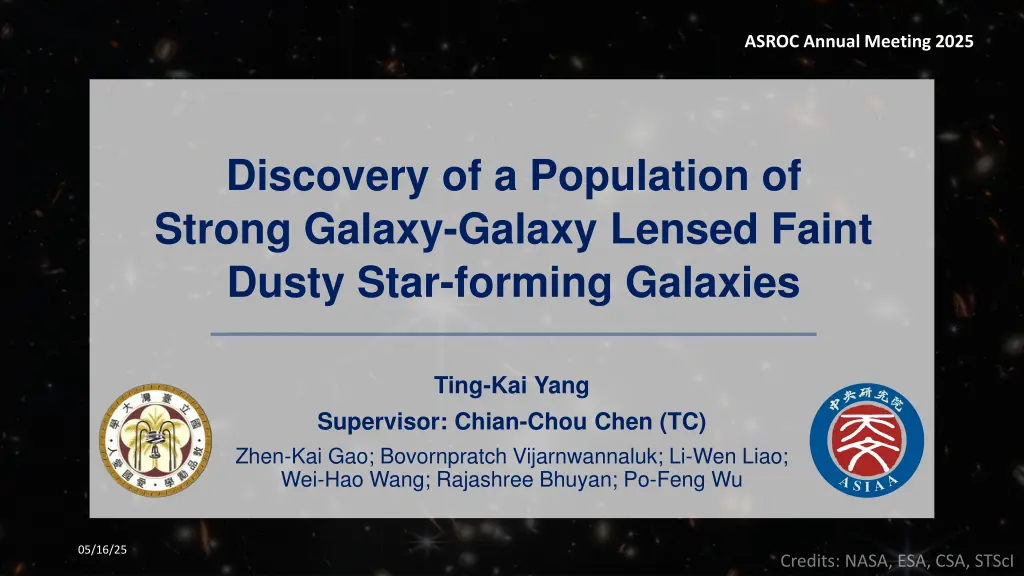
Discovery of Strongly Lensed Dusty Star-forming Galaxies at ASROC Annual Meeting 2025
Uncover the intriguing population of strongly galaxy-galaxy lensed faint dusty star-forming galaxies presented at ASROC Annual Meeting 2025 by Ting-Kai Yang and team. Explore the significance of strong gravitational lensing and their impact on understanding the universe's mass distribution. Delve into the number density model and case studies by Casey et al. to enhance knowledge about these enigmatic galaxies.
Download Presentation

Please find below an Image/Link to download the presentation.
The content on the website is provided AS IS for your information and personal use only. It may not be sold, licensed, or shared on other websites without obtaining consent from the author. If you encounter any issues during the download, it is possible that the publisher has removed the file from their server.
You are allowed to download the files provided on this website for personal or commercial use, subject to the condition that they are used lawfully. All files are the property of their respective owners.
The content on the website is provided AS IS for your information and personal use only. It may not be sold, licensed, or shared on other websites without obtaining consent from the author.
E N D
Presentation Transcript
ASROC Annual Meeting 2025 Discovery of a Population of Strong Galaxy-Galaxy Lensed Faint Dusty Star-forming Galaxies Ting-Kai Yang Supervisor: Chian-Chou Chen (TC) Zhen-Kai Gao; Bovornpratch Vijarnwannaluk; Li-Wen Liao; Wei-Hao Wang; Rajashree Bhuyan; Po-Feng Wu 05/16/25
Dusty Star-forming Galaxies (DSFGs) Observed-Frame Wavelength at z=2 [ m] 10000 1000 100 100.00 Observed Flux Density [mJy] Dusty and high star formation rate Bright in far-IR and submilimeter (Casey et al. 2014) SCUBA-2 10.00 450 m 1.00 850 m 0.10 0.01 Casey et al. 2014 100 1000 10 Rest-Frame Wavelength [ m] 05/16/25 ASROC 2025 | Ting-Kai Yang 1
Strong gravitational lensing Credit: ALMA (ESO/NRAO/NAOJ), L. Cal ada (ESO), Y. Hezaveh et al. 05/16/25 ASROC 2025 | Ting-Kai Yang 2
Why strongly lensed DSFGs? Foreground mass distribution Put constraints on the mass distribution in the Universe DSFGs have higher probability aligning with other foreground galaxies Probe into fainter source Magnified view and detailed investigation of faint sources 05/16/25 ASROC 2025 | Ting-Kai Yang 3
Number density model Blue: strongly lensed DSFGs Orange: unlensed DSFGs Where we are interested Pearson et al. 2024 05/16/25 ASROC 2025 | Ting-Kai Yang 4
Casey et al. 2023 Imaging data JWST NIRCam (PRIMER+COSMOS-Web) ~0.54 deg2 in COSMOS field, ~256 arcmin2 in UDS field F115W, F150W, F277W and F444W JCMT SCUBA-2 450- and 850-micron image (STUDIES, S2COSMOS, S2CLS, S2LXS, etc) 05/16/25 ASROC 2025 | Ting-Kai Yang 5
JWST Threshold Catalog Detected in F444W F150W map for searching red galaxies RGB 05/16/25 ASROC 2025 | Ting-Kai Yang 6
COSMOS field STUDIES DSFG samples COSMOS-Web 1. STUDIES 450-micron counterparts ALMA, VLA or MIPS 2. JWST flux & color selection (Barger & Cowie 2023) 11,873 DSFGs in COSMOS field and 1,425 DSFGs in UDS field High SNR in SCUBA-2 stacking analysis Casey et al. 2023 We made RGB plots and visually identified strongly lensed morphologies 05/16/25 ASROC 2025 | Ting-Kai Yang 7
Results We found 18 strongly lesned candidates in COSMOS field No candidates found in UDS field 7 sources selected from STUDIES 450-micron counterparts 2 of them have been reported (Pearson et al. 2024, van Dokkum et al. 2024) 05/16/25 ASROC 2025 | Ting-Kai Yang 8
Photo-z Photo-z generated with EAZY Photometry 4 bands for sources (JWST) 36~38 bands for lenses (JWST+COSMOS2020) Source photo-z is higher than the lens for all candidates, suggesting potential lensing. 05/16/25 ASROC 2025 | Ting-Kai Yang 9
Lens modeling We applied lens modeling with Lenstronomy(Birrer & Amara 2018 and Birrer et al. 2021) Observed data Best fit model parameter Magnification factor Fitting process Lens mass distribution Constructed model image Light profiles 05/16/25 ASROC 2025 | Ting-Kai Yang 10
Lens modeling 035 for example (SIE, = 2.5) 13 candidates were confirmed as strongly lensed 05/16/25 ASROC 2025 | Ting-Kai Yang 11
Compare to number density model Blue solid: Negrello et al. 2017 Blue dashdot: Sedgwick et al. 2025 05/16/25 ASROC 2025 | Ting-Kai Yang 12
Field-to-field Variation 13 strongly lensed faint DSFGs in COSMOS field; none in UDS field Higher convergence within STUDIES footprint Nightingale et al. 2025 05/16/25 ASROC 2025 | Ting-Kai Yang 13
Summary We searched for strongly lensed faint DSFGs using JWST imaging data 13 strongly lensed faint DSFGs were identified in COSMOS field, but no strongly lensed candidates found in UDS field, showing a field-to-field variation Our observed result is consistent with the model predictions for strongly lensed DSFG number density, supporting the existence of a faint strongly lensed DSFG population The lensing systems we found are expected to be detected with Euclid, more strongly lensed faint DSFGs may be discovered in the future 05/16/25 ASROC 2025 | Ting-Kai Yang 14






















